Читать книгу An Introduction to Intercultural Communication - Fred E. Jandt - Страница 64
На сайте Литреса книга снята с продажи.
Focus on Skills 2.1 Assessing Intercultural Communication Competence
ОглавлениеRead the following court transcript:
Magistrate: Can you read and write?
Defendant: Yes.
Magistrate: Can you sign your name?
Defendant: Yes.
Magistrate: Did you say you cannot read?
Defendant: Hm.
Magistrate: Can you read or not?
Defendant: No.
Magistrate: [Reads statement.] Do you recall making that statement?
Defendant: Yes.
Magistrate: Is there anything else you want to add to the statement?
Defendant: [No answer.]
Magistrate: Did you want to say anything else?
Defendant: No.
Magistrate: Is there anything in the statement you want to change?
Defendant: No.
Magistrate: [Reads a second statement.] Do you recall making that statement?
Defendant: Yes.
Magistrate: Do you wish to add to the statement?
Defendant: No.
Magistrate: Do you want to alter the statement in any way?
Defendant: [Slight nod.]
Magistrate: What do you want to alter?
Defendant: [No answer.]
Magistrate: Do you want to change the statement?
Defendant: No.
1 Assess the intercultural communication competence of the magistrate and the defendant from the transcript alone.
2 The defendant is an Aboriginal in an Australian court. Liberman (1990a, 1990b) describes the unique form of public discourse that evolved among the isolated Aboriginal people of central Australia: Consensus must be preserved through such strategies as unassertiveness, avoidance of direct argumentation, deferral of topics that would produce disharmony, and serial summaries so that the people think together and “speak with one voice.” If any dissension is sensed, there are no attempts to force a decision, and the discussion is abandoned. Western European discourse style is direct, confrontational, and individualistic. Thus, it can be said that the Aboriginal defendant in the example finds it difficult to communicate a defense by opposing what has been said and rather frequently concurs with any statement made to him (Liberman, 1990b). Now that you have this information, does the defendant’s strategy of giving the answers “Yes,” “No,” or “Hm” to placate the magistrate demonstrate intercultural communication competence?
3 Obviously the magistrate knows the defendant is an Aboriginal. Does the magistrate’s questioning demonstrate intercultural communication competence?
Source: Quoted in Liberman (1981).
Chen (1989, 1990) identifies four skill areas: personality strength, communication skills, psychological adjustment, and cultural awareness.
